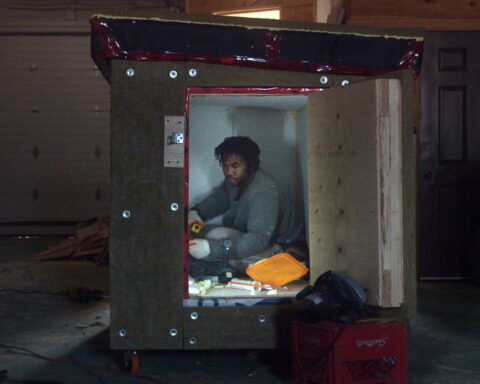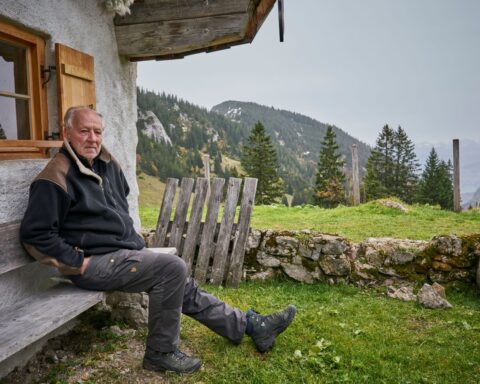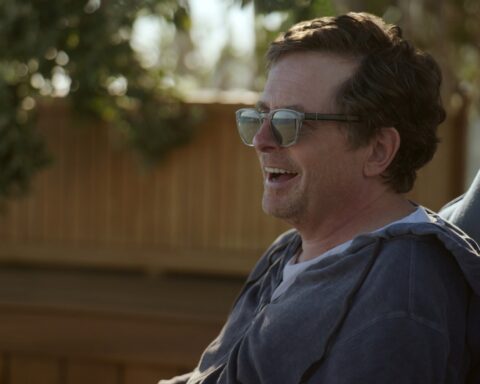Last year, my Toronto International Film Festival (TIFF) article was titled Larger Than Life. With the remarkable experience that it was, I wondered how the 2011 festival could possibly compare. It was my privilege to return this year for Point of View and discover how TIFF outdid itself.
The energy of this festival is a palpable force, radiating outwards from the Bell Lightbox. Heavyweight directors this year included Jonathan Demme, Wim Wenders, Davis Guggenheim, Werner Herzog, Ron Fricke, Frederick Wiseman and Cameron Crowe. Documentary subjects included superstars Neil Young, U2 and Pearl Jam. All attended.
This year documentaries moved to centre stage, occupying spots usually taken by dramas. How often does the headline “Docus Step Out” grace the cover of Variety? For the first time, TIFF opened with a documentary— From the Sky Down, Davis Guggenheim’s film about the Irish rock group U2. And, in another precedent, a documentary won Telefilm Canada’s Pitch This! The Leone Stars’ “team.” Allan Tong and Ngardy Conteh, pitched a story about a single-leg amputee soccer team’s quest for world champion status, and knocked one out of the park.
The power of the entire film industry is channelled not only through the festival, but now through its embodiment as well: the Bell Lightbox. The building is the pinnacle and TIFF is the energy—together they are a lightning rod for the art of film. Here’s how I was struck.
Day 1
As a huge U2 fan, I found From the Sky Down to be a big disappointment: it was void of intimacy. At the same time, fans will find it worth seeing because it’s the closest that U2 will let you in. The real intimacy was in the press conference, where the adversarial relationship between director and subjects was laid bare. On one hand, there’s Davis Guggenheim (Oscar winner, An Inconvenient Truth), noted for getting access to the famous—and U2 on the other, who have spent their entire career protecting themselves from the media. Who’s gonna win that one?
Even if U2 had wanted to open up, I’m sure it would have taken a lot of time to build the necessary trust. But this film was rushed. Bono, who’s used to calling the shots, stated that the feeling he was left with, as a documentary subject, was of being kidnapped and locked in the trunk of a car. I actually felt sorry for Guggenheim. Given the chance to ask one final question of the band, he sheepishly asked, “Do you guys like me?” Ouch.
Day 2
The main message I retained from the “Meet the Funders” panel is that the big Canadian funding agencies really don’t want to hear from first-timers until they have the film in the can. They seemed surprised to field a question about support for documentaries and didn’t have much to say on the topic other than, “Yeah, we support documentaries…too.”
I bumped into some of the speakers later and they back-pedalled a fair bit. Knowing that they do support documentaries, it must have been challenging not to find the right words in the heat of it. I guess they simply weren’t expecting to talk about it in a venue not specifically about docs.
Next, I spontaneously decided to see Pearl Jam 20. Truth be told, I would usually switch stations when a Pearl Jam song came on the radio. My real curiosity was about the Oscar-winning director Cameron Crowe. I walked into the film knowing very little about the band and came out thinking that I’d just seen one of the five best rock movies ever and that I would see them live any day. I bumped into their publicist outside the theatre and promptly got my wish: the press conference was about to start.
Pearl Jam have quietly documented their own story on video from the beginning, and kept it all to themselves—until now. As opposed to From the Sky Down, where you never really lose the feeling of being an outsider, with PJ 20, you’re on the bus, writing the songs with them. Having a director of Crowe’s stature doesn’t hurt, especially considering he first met Pearl Jam in 1992, while working as a rock journalist. PJ 20 is the kind of film that can only be made with that kind of access, built on a trust grown over many years.
Day 3
Peter Broderick, an independent distribution expert, hosted a panel, “Activating Your Audience,” and he never fails to inspire. This time he brought along the DIY director of Urbanized, Gary Hustwit. Hustwit talked about raising outrageous amounts of cash through social networking and crowd-funding for all three of his films and then selling DVD packages when the docs were ready for distribution.
Next stop was the “Art of the Impossible” panel with producers Mark Lipson (Errol Morris’s Tabloid) and Mark Magidson (Ron Fricke’s Samsara). Both were very down-to-earth. You would think that a producer who works with Morris, an Oscar-winning director, would be consumed with…well, producer things. Lipson actively works as a post-production supervisor and stills photographer on top of producing. I could feel things shift in the room as Lipson spoke. It allowed everyone to drop their pretensions.
Then I headed off to see I’m Carolyn Parker: The Good, the Mad, and the Beautiful, Jonathan Demme’s latest (of two at the festival— he also made a rock doc, Neil Young Journeys). My heart sank as the lights went down and the screen baffles adjusted to a 4:3 aspect ratio. It didn’t take long to come to terms with that, though, and realize that the format was perfect for the long close-ups of Parker. It’s a very slow film, but an important one. That a star director like Demme would simply hang out for a long time with a Hurricane Katrina survivor as she fights to reclaim her home and community is a testament to both the man and the subject. It’s a wonderful piece of cinema, highlighting the importance of telling simple, human stories.
Tempting as it was, I was thinking about passing on Neil Young Journeys. Demme had told me in the past that he draws a very distinct line between his music films and his documentaries. So, I wasn’t expecting the last of his trio of Neil Young films (Neil Young: Heart of Gold and Neil Young Trunk Show are the others) to be much of a documentary. Then the fan in me took over. It was a bit of self-gratification, but turned out to be on the money. The film is a concert piece, punctuated with a road trip filmed from the passenger seat as Young drives from his childhood home in the fabled “North Ontario” (Omemee) to Massey Hall.
Young and Demme were both in attendance, sitting about 10 rows behind me. It was as close as one could ever get to watching a movie in one’s living room with Neil Young. The presentation was exactly as Young wanted. He had his soundman do the audio. The film opens with a single note on an acoustic guitar—and the theatre did shake.
Environmentalists, skip this paragraph—Young has softened up, and shared some childhood stories involving turtle orifices and firecrackers. If you are a Neil Young fan, this film is a must. The Q&A was similarly intimate. Young’s Grade Four sweetheart was a surprise guest—“Mary-Ellen, is that you?”—and a boy from Omemee who had convinced the childhood Young to eat tar also sent a letter. Young was certainly moved and very friendly throughout. Being the only photographer, I snapped away relentlessly from about eight feet away. Young occasionally looked straight down at me—must have been wondering, “Still shooting, lad? Aren’t you done yet?” Fortunately, his good mood lasted to the end.
Day 6
I realize that my plans had evaporated. I was in a TIFF free-fall and had missed screenings of some key films I wanted to see. Fortunately most were available at the press-screening library.
Arirang is Korean director Kim Ki-duk’s self-shot film about his reclusive recovery from the trauma of a near-death incident on one of his film sets. Kim states near the opening that this film “might be a drama, might be a documentary,” and it’s an honest statement. About a third of the way through the film, a second iteration of Kim appears during a soliloquy and remains as a second character to the end.
This device is brilliant and comes off as less of a contrivance than the previous coverage he’d shot of himself going through life in an isolated cottage. The POV shots and cutaways used prior to the second Kim’s appearance were a little troublesome (despite the opening statement), partially because he was never shown holding a camera. But, once the second Kim presents himself, it’s all OK because both legs are now clearly over the fence. A self-reflexive, innovative and earnest film.
Ron Fricke (director/cinematographer, Samsara, Baraka, Chronos and cinematographer, Koyaanisqatsi) is the Eric Clapton of time-lapse cinematography. He looks me straight in the eye as I interview him and says, “Samsara is a guided meditation on the cycle of life, death and rebirth.” I ask Fricke the same question posed to producer Magidson at the panel: “Has your life been impacted by the making of such a deep film? Are you the same as when you started this project?” Same response from both of them: it’s just a movie. I think the humility is part of their agenda—let the audience come to their own conclusions. Samsara is a stunning achievement in cinematography, shot on a 65mm motion-control system designed by Fricke more than 20 years ago and projected in 4K—twice the information and detail of previous digital standards—at the Lightbox. It’s astonishing and a first at TIFF.
Samsara was made with three Panavision 65mm cameras, two for live action and one for motion control. They had a core crew of only five people. Everything packed into five-foot flight cases. It’s an amazing accomplishment for such a small team.
I used the opportunity to pose a question that Eric Kessler (of Kessler Crane), a fabricator of affordable motion-control equipment very popular with DSLR shooters, wanted me to ask. “Did you ever think that your work would inspire so many other people to follow your path in the genre of motion-control time lapses?” Fricke, typically humble, said, “No.”
Another big moment for me was the Bruce McDonald master class. I hadn’t seen McDonald in a long time and if there’s a Canadian director I want to be like when I grow up, it’s him. A while back he very generously gave me some bang-on advice and a letter of recommendation that helped me gain admission to the Canadian Film Centre and eventually led to the completion of my first broadcast film. I’d seen his recent doc about Rita Chiarelli making music with inmates at Angola Prison, Music from the Big House, and was grateful for the opportunity to acknowledge the achievement in a forum like the master class. As usually happens in these environments, someone else asked my burning question: “What’s the biggest challenge you’ve ever faced—do you have any regrets?” In typical McDonald fashion, he replied, “I usually keep looking to the future.”
The Tall Man, directed by Tony Krawitz, about the fallout from the death of a local in police custody in a small aboriginal community on Palm Island, Australia, was the most moving film I saw at TIFF. See this film. The film plays out like a victim impact statement for an entire community, starting with footage of the unrest that follows the death of Cameron Doomadgee, imprisoned for swearing at a policeman. Within 45 minutes of being incarcerated, Doomadgee is found dead of a blunt-force trauma strong enough for his spine to split his liver. Enter the Tall Man, the arresting police officer, a looming presence on Palm Island and self-admitted racist, who is unflaggingly defended and protected by the full weight of his police force and regional government.
Beautifully shot and movingly scored, The Tall Man is a poignant story that in time will be a testament to just how far we haven’t come, to this day. Here’s something from the TIFF programme notes: “The Tall Man will have a special resonance for Canadian audiences, as we have only recently begun to grapple with the dark history surrounding the systemic mistreatment of our country’s First Nations people.”
Day 9
My last full day and it’s hard to believe how quickly TIFF has gone by. Tahrir 2011: The Good, the Bad, and the Politician is the subject of my final interview. Co-directed by Tamer Ezzat, Ayten Amin and Amr Salama, it’s a film in three parts about the Egyptian revolution. In the spirit of the selfless nature of the filmmakers, Ezzat actually kicks things off by interviewing…me.
United in their purpose to expedite leadership change in Egypt, each part is a unique expression: an inside look at the unsung heroes who boldly occupied Tahrir Square; interviews with Mubarak’s enforcers, the police; and a satirical and universally scary look at the makings of a dictator, reminding us that it can happen anywhere.
The filmmakers risked a great deal to make this film during the revolution, and the results epitomize the use of documentary to create social change. Footage was sourced from thousands of people who felt it was the best way to show the rest of the world the crimes of the Egyptian police.
I asked Ezzat what the current state of affairs is in Egypt. “Egypt right now is like an old broken bus. Those who are pro-revolution are trying to push the bus forward. The Islamists are leaning, pretending that they are pushing, taking credit; the military council are inside the bus, pushing the brakes; and the silent majority, which we call the party of the couch, are sitting at home, angry and complaining, ‘Why is the bus not moving?’ There are many convictions but nobody knows which of these will be the truth.”
The Last Dogs of Winter (dir. Costa Botes) is a New Zealand film shot in Churchill, Man., about a Kiwi actor, Caleb Ross, who joins the struggle to save an endangered species: Eskimo dogs. It’s a fabulous story about resilience, survival, co-existence and purpose, with unbelievable footage of the chained dogs facing polar bears.
It’s largely the unlikely story of how a New Zealander ends up in Canada’s Arctic searching for what’s next. Says Ross, “I think that we all just play roles through life, to be honest. This is one role I’m playing right now and I’m sure I’ll play a lot of others. In life I feel like I can play any role I want to right now.”
And with that I put down the headphones and bid adieu to my volunteer friends who diligently run the press-screening library. Wolfing down one final hors d’oeuvre in the press lounge, a smile comes to my face as I recall something from day one. Bono’s words ring in my ears: in the creative process, “You’ve got to risk everything.” Inspired, yes, but more importantly, I leave TIFF 2011 empowered.
Day 11
I unhitched my wagon from the festival and took a plane to “North Ontario” to film a profile of the winner of a National Aboriginal Achievement award. I left TIFF 2011 wondering what the next 12 months would bring in the world of documentary. The festival may have ended, but for documentarians the world over, the spirit lingers.
Special thanks to Real to Reel publicist Kelly Meehan for her warm inclusiveness, and to Shangri-La Hotels for providing a five-star experience at the press lounge.











